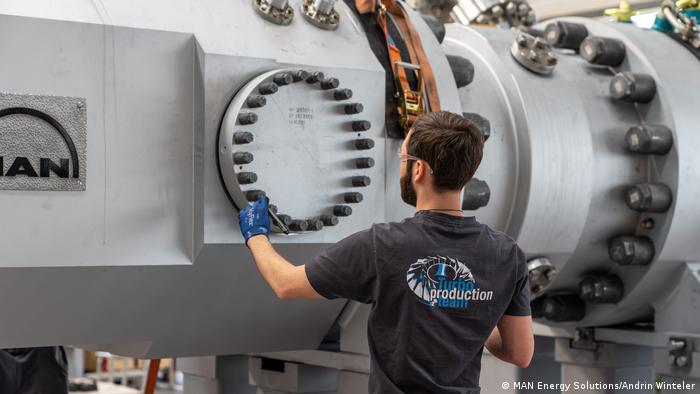ENVIRONMENT
Energy crisis: Can large-scale heat pumps replace fossil fuels for heating?
Oil, coal and gas still provide most energy for heating in Germany. Large-scale heat pumps offer a cost-effective, climate-neutral alternative that use waste and environmental heat.
A man services a large heat pump at a factory in Zurich
Large heat pumps could offer a climate-neutral alternative to fossil fuels
As Germany and other European countries seek to move away from oil and gas heating in the face of a looming energy crisis, and to meet climate protection targets, Stockholm is leading the way. Some 98% of heating in the Swedish capital is provided by renewable or recycled heat energy.
The trick? Large-scale heat pumps that use excess energy. Waste heat from industrial plants, wastewater, data centers and soon from an electricity transformer station, as well as environmental heat from the Baltic Sea, flow into the city’s district heating network, supplying most of its buildings.
The European Union has more than 6,000 district heating networks, which meet some 11% of the bloc’s heating needs. The challenge now is to switch those away from fossil fuels. District heating is any heating system with a centralized source of heat. They’re often based around urban centers.
Decentralized heat pumps more efficient
Large power plants burning gas, oil or coal supply most heating networks. Some also use waste heat from nuclear power plants and deep geothermal energy. But in recent years, suppliers are increasingly adding waste incineration, bioenergy and large solar thermal plants, as well as heat pumps to the mix.
Infografik Wärmenetz EN
Experts see large-scale heat pumps, like in Stockholm, as having the greatest potential to supply cities with cheap and climate friendly heating.
“We will not convert the district heating networks in one fell swoop, but must decarbonize the heating networks step-by-step,” said Nikolaus Meyer, head of solutions development at energy group E.ON based in the German city of Essen.
According to Meyer, in the future large heat pumps will extract heat from various places in a decentralized way. The heat will come from the ground, bodies of water, the air, wastewater, subway tunnels and industry.
An additional portion of climate-neutral heat demand could be met with deep geothermal energy, bioenergy, solar thermal energy, surplus green electricity and synthetically produced green hydrogen, say experts.
Integrating heat pumps into existing urban heating networks shouldn’t present too many technical challenges, at least in theory. Such networks transmit heat as energy using warm water. The water temperature is usually between 80 to 130 degrees Celsius (176 to 266 degrees Fahrenheit).
Large heat pumps can also reach temperatures of over 130 degrees Celsius but they work more efficiently if they only have to generate lower temperatures. With one kilowatt-hour of electricity, systems generate about five kilowatts of heat with hot water at 70 degrees.
“Our target is toward 70 degrees in the grid, so that we can also exploit the potential for efficiency in heat pumps,” Meyer said.
Germany seeks cheaper, more efficient heating source
Sweden, along with Denmark, has been pushing ahead with the phase-out of coal, oil and gas in the heat supply sector for years. They’ve been expanding district heating networks and switching to renewable energy and large heat pumps. The share of renewable heat in networks is now over 60% on average for both countries.
A small-scale domestic heat pump in Germany
Small-scale domestic heat pumps are also being an increasingly common sight in Germany
Stockholm is going one step further. The Swedish capital plans to make its heating supply free of fossil fuels by 2025. And it hopes to further help the climate by capturing CO2 from biofuel heating facilities and injecting that carbon deep underground. As the plants used to make the biofuel have already absorbed CO2 from the air during the growth process and that CO2 is then stored after the fuel is burned, emissions are, in theory, negative.
Germany behind other countries on heating transition
With a 15% share of renewables in district heating, Germany lags far behind its Scandinavian neighbors. Gas accounts for 41% and coal 30% of heating energy in the country, according to 2018 figures. The share of fossil fuels in district heating is so high largely because of the subsidy policy of the previous government, which was led by former Chancellor Angela Merkel who left power 2021.
Thanks to those policies, gas, especially from Russia, was very cheap. The use of gas and coal in combined power plants to generate electricity and heat was also heavily subsidized for years. Against that economic background, the installation of large-scale heat pumps incorporating renewables was neither attractive to utilities nor politically desirable.
But now the political and economic conditions have changed fundamentally. Since the Russian invasion of Ukraine, the price of natural gas has quadrupled compared to previous years. Gas heating is now significantly more expensive than large-scale heat pumps, geothermal and solar thermal energy and biomass.
The current German government now wants to promote renewable heat generation, heat pumps and a green district heating expansion to the tune of €3.8 billion ($3.8 billion) over the next four years.
“Green district heating networks are key to a climate-neutral heat supply and crucial to reducing our dependence on fossil energy imports,” said Robert Habeck, German Minister for Economic Affairs and Climate Protection, in early August, after the European Commission approved the funding programs.
“Connecting to increasingly climate-neutral district heating is the best solution for moving away from oil and gas heating, especially in cities and densely populationed areas,” Habeck added. “Many municipalities are at the beginning of the process of converting their heat supply.”
This article was translated from German
Play Video2:38 min
Demand for solar energy and heat pumps soars
DW RECOMMENDS
Carbon capture: Climate solution or prolonging humanity’s fossil fuel dependency?
Capturing and burying CO2 is heralded as the technological fix to mitigate climate change. But many oil and gas majors are using the technology to produce more fossil fuels.
Corporate CO2 targets: Greenwashing or genuine climate action?
From Big Oil to Big Tech, major companies are promising to go net zero and wash away their carbon sins. But critics say the corporate climate pledges are a smokescreen.
Date 16.09.2022
Author Gero Rueter
Related Subjects Robert Habeck, Stockholm, Energy crisis
Keywords heat pumps, renewable energy, green energy, district heating networks, Stockholm, Robert Habeck
Feedback: Send us your feedback.
Print Print this page
Permalink https://p.dw.com/p/4GZ8a

























